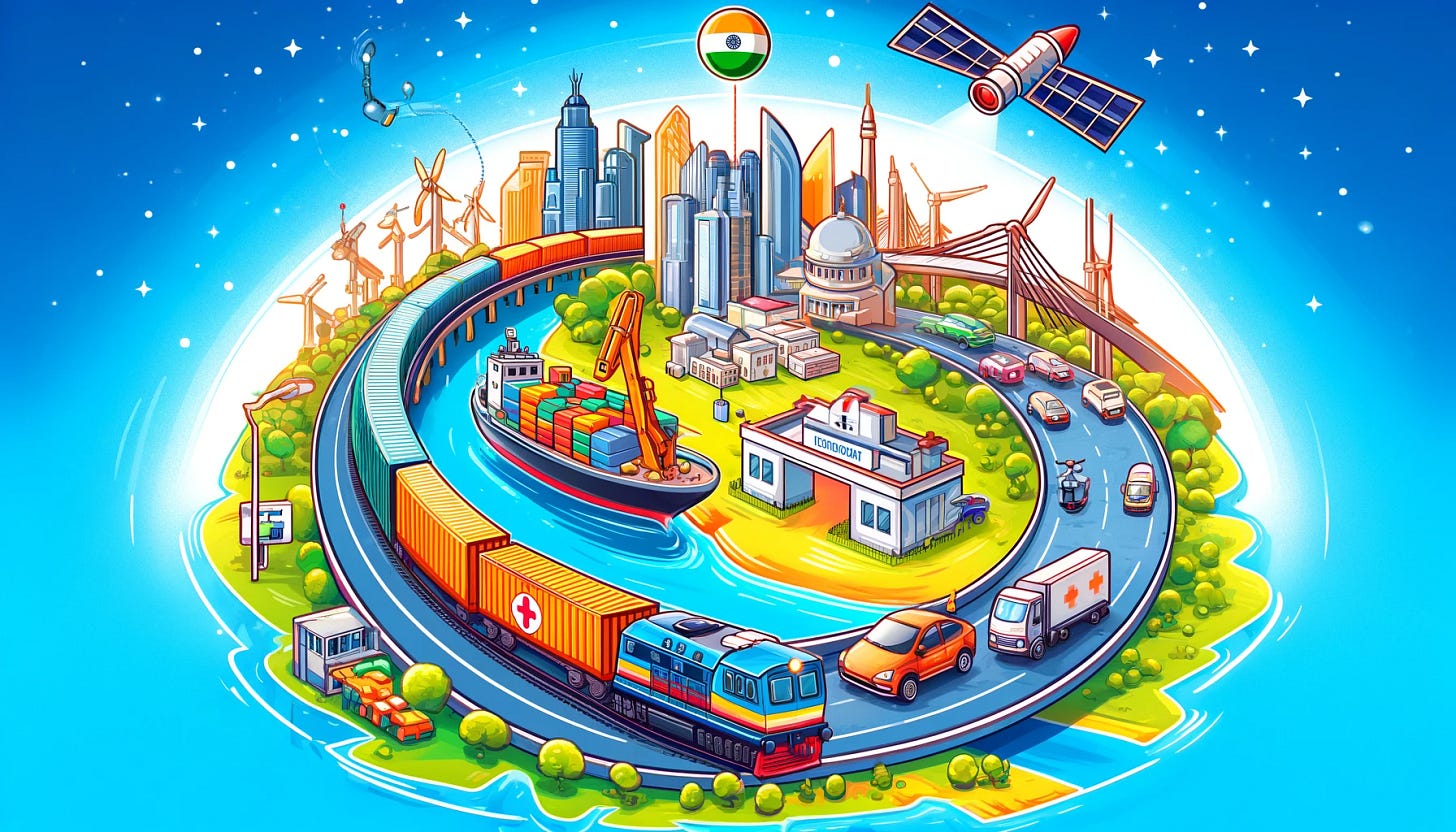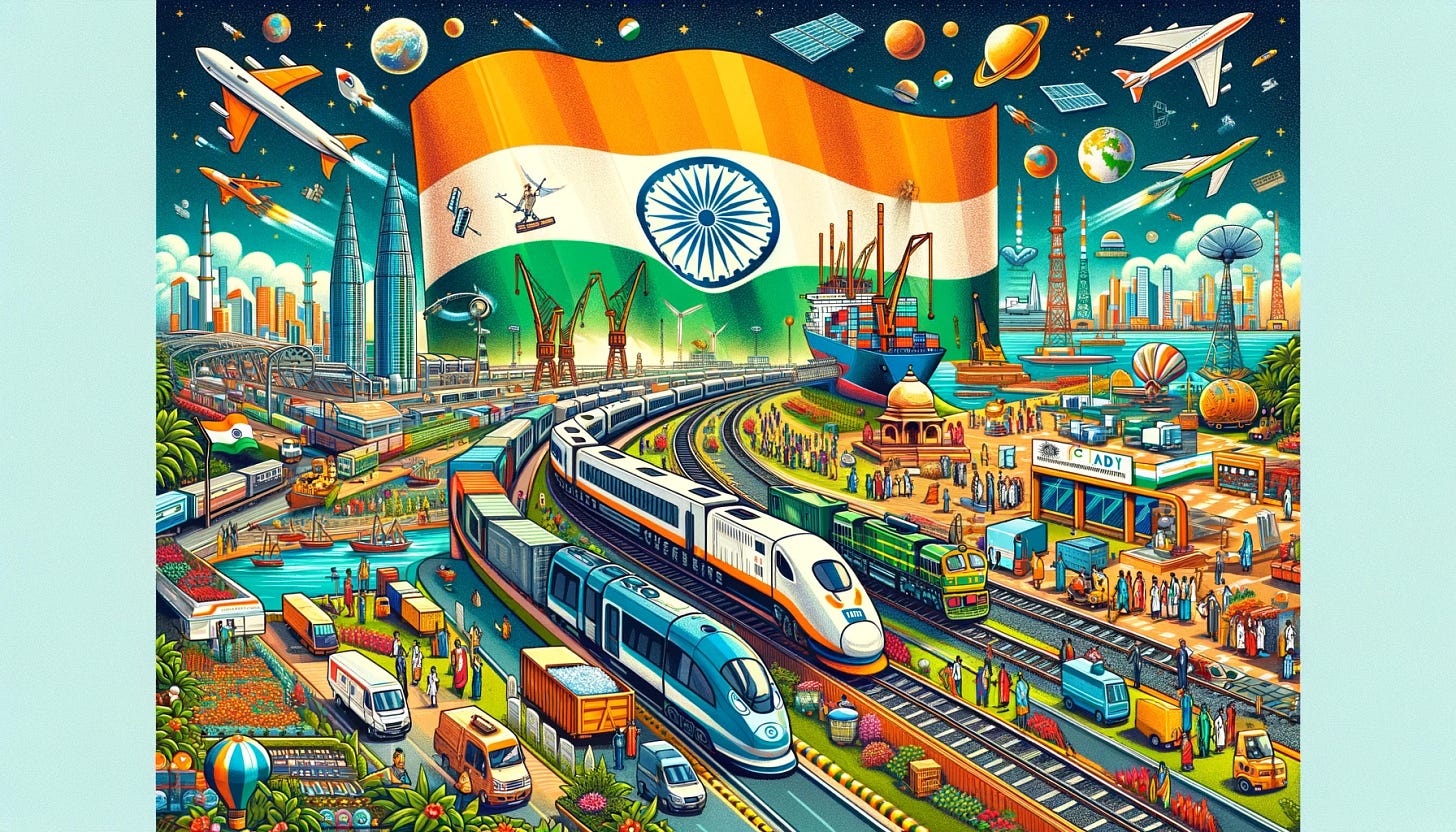PRAGATI Initiative—Beyond Modi's Ribbon-Cutting Obsession: Cutting the "Red Tape"
India's Infrastructure Overhaul Under Modi.
Updated Version
More than mere Ribbon-Cutting
When it comes to ribbon-cutting ceremonies, Prime Minister Narendra Modi leads by example1. Whether it’s flagging off a new train or remotely inaugurating an airport or bridge, Modi’s personal touch on India’s infrastructure is unmistakable. In fact, he has been in power long enough that at some projects, both the foundation stone and the inauguration plaque bear his name.
Photo-Ops and Political Strategy
While the spectacle of Modi at every project unveiling may seem excessive to some, there’s sound political reasoning behind it. A Government’s success is measured by its achievements, and for Modi, physical infrastructure is the emblem of progress. Highways, airports, and trains are prominently showcased by the Bharatiya Janata Party (BJP) as evidence of their governance. Despite inefficiencies like delayed trains and inconsistent flight operations, supporters highlight new intercity transport routes as a testament to the Government's commitment.
Efficiency in Governance through PRAGATI Meetings
PRAGATI2 (Pro-Active Governance and Timely Implementation) meetings, initiated by Prime Minister Narendra Modi, have revolutionized the way government projects and issues are handled by introducing a highly efficient, interactive platform for real-time governance. These meetings, held monthly, focus on addressing grievances, monitoring flagship projects, and resolving inter-departmental issues that often delay the implementation of critical initiatives. By connecting the senior-most civil servants of the central and state governments digitally, PRAGATI helps in resolving long-standing issues like land acquisition and environmental clearances, which traditionally took years to sort out due to bureaucratic delays.
Firsthand Experience of the Impact of PRAGATI
Having had the opportunity to virtually attend a couple of these meetings on behalf of the State of Punjab, I have witnessed firsthand how PRAGATI effectively cuts through red tape. Critical infrastructure projects, often stalled by prolonged processes of land acquisition and environmental clearances, were expedited remarkably. Issues that typically required lengthy correspondences between various ministries and state departments were resolved within minutes during these sessions. This not only saved years, potentially decades, of stagnation but also demonstrated the potential of digital governance in accelerating project execution and enhancing service delivery.
Critics and Comparisons to China
Critics, however, argue that the pace and scope of infrastructure development are insufficient compared to China. Despite India's noticeable progress, they say its achievements pale beside China’s massive and rapid transformation. India's development timeline has been slower and less ambitious, with many projects lagging behind their projected schedules. Although there have been improvements, sceptics maintain that the rate of change remains sluggish, preventing India from fully realising its potential in the global marketplace.
Going Beyond Concrete and Steel
Infrastructure isn't just about pouring concrete and laying steel. Capacity in railway networks can be optimised with modern signalling systems, while expressway speeds improve with electronic tolling. Goods transportation is streamlined with harmonised tax structures. The Modi government has made strides in these softer infrastructure elements. For instance, the electronic tolling system FASTag, introduced in 2014, has reduced traffic at highway toll plazas. The 2017 Goods and Services Tax (GST) minimised local tax barriers, leading to smoother interstate transport. Though signalling systems still need attention, an automatic accident-prevention mechanism is being implemented on rail tracks, and most mainline railways are now electrified.
Ports: A Showcase of Improvement
India's port infrastructure epitomises the country’s reformative potential. Jawaharlal Nehru Port, located across the harbour from Mumbai, has benefited from a combination of private terminal operations and streamlined digital paperwork. As India’s largest government port and the main hub for container trade, it's a pivotal part of the country’s logistics network. The movement of lorries is coordinated like clockwork, thanks to privatisation and the digitalisation of customs processes. The customs department has shifted its mindset towards service, reducing excessive inspections and improving efficiency.
Future Potential and Challenges
Despite these successes, challenges remain. Import processing speeds have improved, but exports still face delays at docks. The Indian government, across successive administrations, has shown remarkable ability to execute projects with specific goals, such as expanding schools and building hospitals. However, achieving sustained improvements remains challenging, with new hospitals often underfunded and students still struggling with literacy. Furthermore, unemployment is a broader issue, where securing a government job remains the cherished dream of an ordinary graduate.
India’s ports stand as a testament to the government's ability to make significant progress when committed, though this sometimes falls short of international comparisons. As Prime Minister Narendra Modi leads from the front in the ongoing Lok Sabha elections, which he is widely expected to win, the future direction will be clear by the evening of June 4th. The results will indicate whether a potential Modi 3.0 administration can further accelerate infrastructure development over the next five years, expanding on the progress made thus far to achieve broader, sustainable growth.
Adapted from “The Economist”, with our own critique.
PRAGATI (Pro-Active Governance and Timely Implementation) is an initiative launched by Prime Minister Narendra Modi in March 2015. It is a multi-purpose and multi-modal platform aimed at addressing common man’s grievances and simultaneously monitoring and reviewing important programs and projects of the Government of India as well as projects flagged by State Governments.
Key Features of PRAGATI
Interactive Platform: PRAGATI provides a unique integrating and interactive platform, designed in-house by the Prime Minister’s Office (PMO) in collaboration with the National Informatics Centre (NIC). The system is used for real-time governance and promotes a culture of pro-activity and monitoring.
Monthly Meetings: Prime Minister Modi chairs monthly meetings via video-conferencing with top government officials from various Central government departments and State governments. These meetings are scheduled to discuss and resolve issues with the implementation of various programs and schemes.
Multi-dimensional: The platform brings together the central and state governments, where attention is given to a wide range of subjects including infrastructure projects, governance issues, Swachh Bharat initiatives, and other economic and social sectors.
Real-Time Data and Feedback: During the meetings, visuals and presentations are shown on a large screen, enabling the Prime Minister to directly interact with the officials in charge of the various tasks and projects. This helps in getting real-time data and feedback on the work being done on the ground.
Focus on Outcomes: PRAGATI’s design emphasizes timely results by keeping track of the progress of various initiatives against pre-defined timelines and targets.
Impact and Objectives
The primary objective of PRAGATI is to instill a sense of urgency and accountability in the administration’s functioning, ensuring the timely delivery of government services to citizens and resolving complex issues with Centre-State and inter-departmental coordination.
PRAGATI meetings are also used as a platform to address grievances of the common people, where PM Modi directly reviews the status of public grievances related to certain flagship schemes and projects. These meetings not only help in the identification of systemic issues in service delivery but also promote reforms across various sectors.
Overall, PRAGATI aligns with the government's push towards e-Governance and efficient, corruption-free service delivery mechanisms, aiming at holistic progress and governance improvements.




